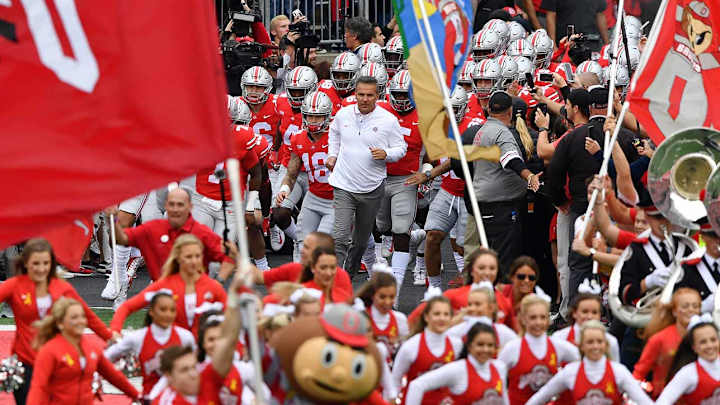Urban Meyer's First Game Back Hints at How Ohio State Fans Move On

COLUMBUS, Ohio — It was a textbook gameday at Ohio State: cloudy sky, crisp temperature, tailgate tents that had sprung up by mid-morning. There was nothing so unusual about anything in the hours that passed before the Buckeyes walloped Tulane, 49–6, to go to 4–0 and continue on course toward the College Football Playoff.
I was there but, without a media credential and removed from the sterile press box, not for the usual reasons. Instead, I was there for a similar reason to many of the fans in scarlet and gray: because I was born into a certain family, which loves a certain team. That team happens to be Tulane, which counts my father, two of his cousins, five of my cousins and my brother as alums. There were babies in Buckeye onesies. I was once a toddler in a Tulane cheerleader dress. They’re not so different, really—except Ohio State wins.
When my parents first floated the idea of making the trip to Columbus more than a year ago, I thought it’d be a fun weekend to spend with family and friends. I never imagined I’d write. But in August, when Ohio State released the details of Urban Meyer’s suspension—three games, as the result of an investigation into what he knew about the domestic violence allegations against Zach Smith while he was a Buckeyes assistant—I connected the dots that Tulane was set for Week 4. My parents had bought tickets to something more than just a routine blowout.
I’ll admit that the idea of holding a ticket to Meyer’s first game back left me uncomfortable. In the leadup to the game, having written about the Buckeyes and having read the Twitter mentions from vitriolic fans, I thought back to the tiny “rally” held in support of the supposedly embattled Meyer when he was first put on paid administrative leave in early August. I expected more of a homecoming party, something to differentiate this home game from Week 2’s blowout of Rutgers or Week 1’s of Oregon State. Instead, it was a typical scarlet-and-gray fall day under a gray sky, another opportunity to scream and yell and maybe leave at halftime when the stadium stops selling beer. After all, the Buckeyes would be up big by then.
As a writer, it’s easy to hear only the angriest voices: the most defensive fans, the sharpest insults, the most extreme reactions. For those paid to think and feel objectively about sports, it’s easy to deride passion, and I default too quickly to the presence of choice: Your coach/player/athletics director did something bad? Cease to be a fan, immediately! But it’s almost never that easy. Was the Ohio State fan who flagged my family over almost as soon as we got out of the car at the stadium making a statement with his attendance in spite of Meyer’s controversial month? Maybe. But he also chose to reach into a bag in his backseat and hand us each a buckeye, welcoming us to Columbus and telling us to have a great time as his wife laughed and warned us not to eat the poisonous nuts. Saturday was littered with interactions like that, as I traveled in a pack of Tulane supporters. People can rally around the allegiances they’ve held since they were in diapers and simultaneously be welcoming to outsiders less enthusiastic about participating in Meyer’s homecoming. Even something so ultimately trivial as a game can have gray area.
Sure, there were instances of blind support of Meyer. Some fans enthusiastically cheered his return. As I wandered through the early stages of tailgates, I passed two grown men wearing T-shirts made specifically that read “URBAN LEGENDS NEVER DIE”—a tone-deaf sentiment that was probably missing a key piece of punctuation. (Meyer’s wife Shelley also wore a shirt bearing those words.) A 15-minute walk north of The Horseshoe on Lane Avenue, two buildings hung homemade signs from their upper stories. The first depicted a photoshopped image of Meyer holding a tiny Jim Harbaugh underneath text reading “DADDY’S HOME”. The second, a bit farther east, was painted with a crude message comparing Meyer’s return to a hurricane about to destroy Tulane. But these were outliers of bad jokes and poor taste, not any kind of a pervasive sentiment among a fan base doing its best to live a normal Saturday, to move on, to get back to football as usual.
Too often, I decide football is all bad. I’m still not convinced it isn’t, from the injuries to the egos to the undercurrent of misogyny that together seem to constantly threaten the sport’s value. Situations like the one that has unfolded at Ohio State only reinforce that feeling—but it’s easier to feel that disgust on a macro level than it is on the ground, among the actual people for whom these football teams supposedly exist, who have lived the traditions and the championships along with the gutting losses. At a bar near campus after the game, a recent Ohio State graduate walked over to my friends to ask them about their Tulane-themed Mardi Gras beads, a green string with a plastic angry wave mascot attached. She loved them, she said. Could she have a strand? Negotiations ensued. She promised she would go down to Mardi Gras and wear them. Then she walked back to her table and returned with her fist clenched around what she said was a lucky buckeye. She was willing to trade, and the deal was struck, an unlikely cultural exchange. Recommendations for Mardi Gras were issued, and I remembered why I don’t hate football, not really.
Outside the press box, away from the postgame interviews, the coaches and players, I wanted to talk to fans—in bars, on sidewalks, in bathroom lines. I was curious, out here in the wild, how they really felt about this day, that coach and the fact that their football program had for years harbored a man with a record of abuse allegations extending back before his time as an employee at Ohio State. On that last subject, at least, most were incensed. They were clearly still invested in their team—but what about the coach who’d pushed it into such an unseemly spotlight? Two men told me that it shouldn’t be Meyer’s job to monitor his employees’ marriages, that they fundamentally disagreed with the mandatory reporting guidelines coaches are held to through Title IX.
But what if this were another team, another coach? What if someone they knew were involved in this whole stomach-turning mess? It shouldn’t have to come to that, but on the day Urban Meyer returned to the Ohio State sideline, my biggest takeaway was that it does. Winning trumps all, and too many people find it too hard to realize that by condemning a coach’s actions and words they wouldn’t necessarily be condemning the program they adore—even as each isolated incident of ego or misogyny or backward opinions poisons the sport that ties it all together.
